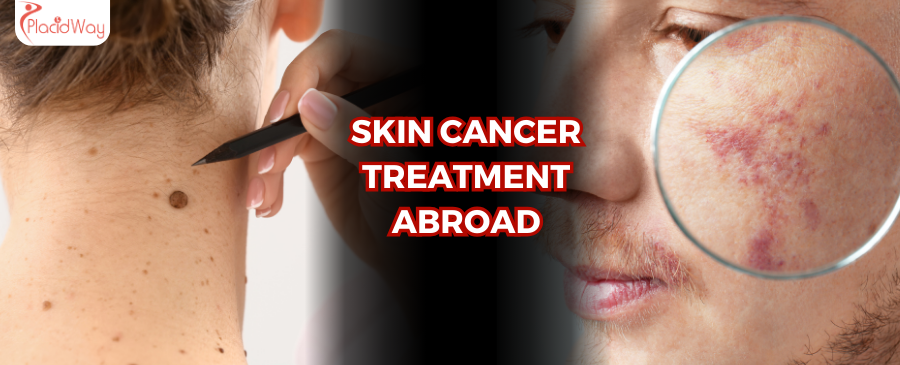Skin Cancer
Cancer Treatment
Modified Date: 2024-11-20

Key Insights at a Glance
- The procedure options for skin cancer vary from non-invasive to surgical, depending on the type and stage of cancer.
- Average cost of skin cancer treatment abroad can be significantly lower than in the U.S., with savings up to 70%.
- Risks can include complications from surgery, recurrence of cancer, and side effects from radiation or chemotherapy.
- Accredited clinics abroad offer high-quality care with advanced technology comparable to Western standards.
- Recovery times can vary, but non-invasive treatments often allow for quicker return to normal activities.
Skin cancer treatment encompasses various procedures aimed at removing or destroying cancer cells in the skin. The primary types of skin cancer — basal cell carcinoma, squamous cell carcinoma, and melanoma — dictate the treatment approach, which can range from localized therapies like cryotherapy and excision to systemic treatments such as chemotherapy and targeted therapy. Treatment choices are influenced by the cancer's type, stage, and location, as well as the patient's overall health.
- New growths or sores that do not heal.
- Changes in existing moles, including size, color, or texture.
- Skin lesions that itch, bleed, or cause pain.
- Development of scaly patches or non-healing ulcers.
| Treatment Type |
Description |
Typical Usage |
| Mohs Surgery |
Layer-by-layer tumor removal |
High cure rate for basal and squamous cell carcinomas |
| Immunotherapy |
Boosts immune system to fight cancer |
Used for advanced melanoma |
| Targeted Therapy |
Drugs that target specific cancer genes |
Advanced or recurrent skin cancers |
| Photodynamic Therapy |
Uses light-sensitive drugs and light to kill cancer cells |
Early-stage or thin cancers |
| Radiation Therapy |
High-energy rays to destroy cancer cells |
When surgery isn't an option |
- Potential for miscommunication due to language barriers.
- Varying healthcare standards and regulations in different countries.
- Risk of complications from travel post-treatment.
- Importance of choosing internationally accredited medical facilities.
- Scarring from surgical procedures.
- Possibility of infection or complications from surgery.
- Risks associated with anesthesia.
- Chance of cancer recurrence or incomplete removal.
The procedure for treating skin cancer varies based on the type, stage, and location of the cancer. Here’s an overview of common treatment options:
-
Simple Excision:
- The cancerous tissue and a small margin of surrounding healthy skin are surgically removed. This is commonly used for non-melanoma skin cancers and is performed under local anesthesia.
-
Cryotherapy:
- The cancer cells are frozen using liquid nitrogen, causing them to die and peel away as the skin heals. Cryotherapy is typically used for early-stage, superficial skin cancers.
-
Topical Medications:
- For certain superficial cancers, topical creams containing medications like imiquimod or fluorouracil (5-FU) are applied directly to the skin. These target and destroy cancer cells over several weeks.
-
Mohs Surgery:
- This specialized surgical technique removes the cancerous cells layer by layer, examining each layer under a microscope until no cancer remains. Mohs surgery preserves as much healthy tissue as possible and is commonly used for cancers on delicate areas like the face.
-
Radiation Therapy:
- High-energy rays are used to target and destroy cancer cells, often for patients who are not ideal candidates for surgery or when the cancer is in a hard-to-reach location.
-
Lymph Node Removal:
- For more advanced melanomas, nearby lymph nodes may be removed if cancer has spread to these areas. This is typically done under general anesthesia.
-
Advanced Therapies for Melanoma:
- Immunotherapy: Medications like checkpoint inhibitors boost the immune system to recognize and attack melanoma cells.
- Targeted Therapy: For melanomas with specific genetic mutations, targeted drugs can directly inhibit cancer growth.
- Chemotherapy: In cases where melanoma has spread, chemotherapy may be used to shrink tumors and control the spread of cancer.
-
Photodynamic Therapy (PDT):
- For certain skin cancers, a photosensitizing agent is applied to the skin, followed by exposure to a specific light source to destroy cancer cells.
The choice of procedure depends on factors like cancer type, stage, location, and the patient’s health, with treatments tailored to balance effectiveness with minimal side effects.
| Country |
Average Cost |
| Mexico |
$1,500 |
| Turkey |
$2,000 |
| Thailand |
$2,500 |
| Colombia |
$1,200 |
| India |
$1,800 |
| Austria |
$3,000 |
| USA |
$5,000 |
| UK |
$4,500 |
Find Prices for Skin Cancer Treatment Near You
What does the Skin Cancer Treatment Cost without insurance?
The cost of skin cancer treatment without insurance can vary widely depending on the type of treatment and the country in which it is performed. Generally, prices can range from $1,200 to $5,000.
What are the success rates of different skin cancer treatments?
Success rates for skin cancer treatments are generally high, especially for non-melanoma cancers if treated early. Mohs surgery, for example, has a cure rate of about 98%.
How long is the recovery period for skin cancer surgeries?
Recovery periods can vary; minor surgeries may require only a few days, while more extensive procedures might need weeks.
Are there any non-surgical options for skin cancer treatment?
Yes, options like cryotherapy, photodynamic therapy, and topical medications are available for non-melanoma skin cancers.
Is it safe to travel after skin cancer surgery?
Traveling after surgery can be safe if adequate healing time has been allowed and with medical clearance from your doctor.
Exploring treatment options for skin cancer abroad can offer access to cutting-edge technologies and significant cost savings. Accredited facilities around the globe provide high-quality care tailored to your health needs. Start planning your treatment journey today and take a step towards recovery and wellness.
